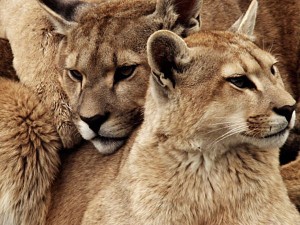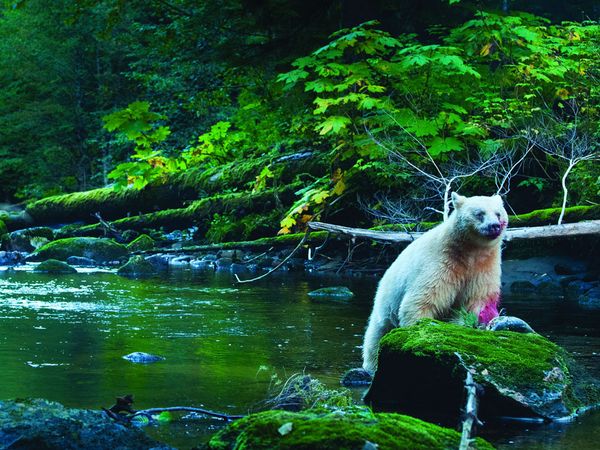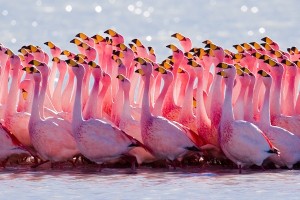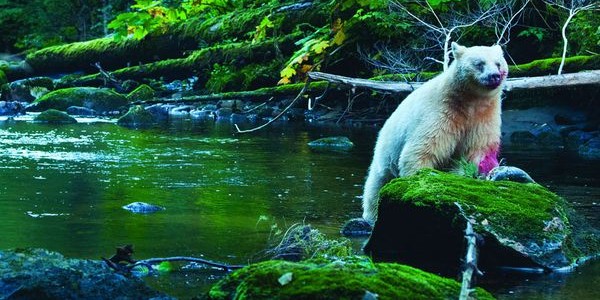‘Untamed Americas’ on Nat Geo: A wild discussion with series producer Kate Bass

Sometimes the most impressive sights and most interesting stories can be found in one’s backyard. In National Geographic Channel’s four-part miniseries, Untamed Americas, cinematographers turn their creative eyes on the “Mountains,” “Deserts,” “Forests” and “Coasts” of North America, Central America and South America. The television event is the first wildlife program of its kind, and has kept series producer Karen Bass busy for a number of years.
In a revealing interview with Hollywood Soapbox, Bass describes the challenges of shooting this never-before-seen footage, which includes mountain lions, long-tongued bats, rays, giant squids and a variety of bears. The stunning results include new looks at old animals, in addition to unbelievable video of natural phenomena that have largely escaped the scrutiny of a camera lens.
Go inside the mountains, deserts, forests and coasts with a woman who finds the engaging stories of our wilderness — all of them, just waiting to be told.
Questions and answers have been slightly edited.
How did the project begin for you?
It was a National Geographic project. It was their idea. Like all these things, I suppose, I got a call. I was in the UK, and I had just left the BBC. I had been with the BBC for over 20 years. I decided to take the leap and cross the pond.
How big was the team working with you?
For this scale and ambition of project, it was a relatively small team. We had two producers. … We had two AP’s, and that was the core of the team. And then, of course, we’ve got some fantastic cinematographers and sometimes those cinematographers were also involved in the setting up, research, R&D of some of the sequences. … We had other backup staff as well, but as you know with these things, making a project of this scale, you need different things at different stages. So at the front end, there’s lots of research, lots of preparation. And really the big thing is to come up with all the right stories and making sure we can get our cameramen in the right place at the right time with the right equipment. And that’s a huge task in and of itself. And then, of course, you’ve got the actual filming and the production, and then there’s the post, and that introduces the editors, and wonderful sound designers, composer Robert Neufeld and his team of musicians that composed this.
Were you surprised by some of the stories and footage the series was able to capture?
I think we always knew what we were trying to film, because, believe it or not, you write those stories based on a lot of local intelligence and local knowledge, very often working with scientists.
So, in the case of the long-tongued bat, that was sort of an A-class story, and we used to sit around looking at the different stories, and I always felt like it was auditioning the animals. And this one was a real star value, because not only was it a new discovery, it was only discovered in the cloud forests of Ecuador in 2005. So no one had ever filmed it before, and the scientists had demonstrated that it has the longest tongue-to-body length ever found in the animal kingdom, certainly the mammals.
That would mean that if you had the tongue at the same proportional length to your body, it would be 9-foot long. We could imagine the water-cooler moment around that one. So let’s set about getting all the right equipment. We’ve got to slow the action down. It’s a nocturnal animal. We’ve got to film that tongue at the base of the flower, which is why it’s got such a long tongue, because it’s trying to get the nectar at the base of a very, very long flower. And we set about trying to capture that on camera.
How did you get perhaps the largest concentration of rays in the ocean? It was almost like a ballet as they swam together and flew threw the air.
I’m glad you share my enthusiasm for that scene. Again, that was somebody locally. One of those things about being in the right place at the right time. That was an event that sometimes lasts hours, sometimes a couple of days, if you’re lucky. So it was actually local cinematographers in Sea of Cortez in Baja, California, that were able to scramble fast enough to capture that.
And everybody locally was telling us, ‘You don’t realize how lucky you are. This is the largest concentration we have ever seen in living memory. Tens of thousands of them.’ As you say, they leap through the air and for something that’s such an amazing spectacle, it’s one of the great shows, when you think about it. It’s probably one of the greatest shows on earth. And they are performing right there in front of you. And people still don’t know why they do it, which I think is amazing, but we still got these questions and mysteries that are still unanswered. We were very, very lucky to capture that on camera.
Did a lot of good stuff end up on the editing room floor?
There’s inevitably some elements of some scenes, and sometimes there are whole scenes that don’t quite make it. You try to plan so that there is no waste. The one thing you can’t foresee is that you might be in the right place at the right time and get that amazing puma footage, that was the case in the ‘Mountains’ show. We managed to film what I think I’ve seen as some of the best mountain lion or puma footage ever.
And you think, you know, it would be great just to get some shots, because they are so, so, so elusive and so difficult to film. But then when you see there’s a whole family and the story emerges that the mother is saying, ‘OK, you’re on your own now guys. You youngsters have got to learn how to hunt and make it on your own, because it’s such a short summer down there.’ And she’s going to leave them to their devices. And then that whole drama of how they are learning to hunt, taking a look at a skunk and thinking, well, maybe not. And then trying to hunt.
You can’t anticipate how much screen time any of these scenes are ultimately going to give you. You can have a very good guess, and you can have an estimate. But sometimes you luck out. Likewise with that grizzly bear scene that was filmed in Yellowstone National Park. That was an incredible, amazing footage … and again we had no idea that we would end up with four or five predation attempts by that mother bear.
Did the structure of four segments come early on in the process?
That was virtually the first thing I did, because you have to have a very, very clear proposition for the audience. … This is the first time that there’s been a series on the whole of the Americas, North, South and Central. And one of the selling points to me about that as a proposition is that it’s a land of superlatives and extremes. You’ve got the longest series of mountain chains from Alaska to Patagonia. You’ve got the most diverse rainforests, the Amazon all the way to the Great Bering Forest in British Columbia. You’ve got the driest desert, the Atacama, as well as the spectacular scenery of the deserts of the Southwest. And, of course, you’ve got the coasts, which encompass the Pacific, the Atlantic, the frozen Arctic and the southern ocean. I mean it doesn’t get a much better stage for wildlife drama to play out than that. I think it was very clear to me that you wanted to be able to really showcase that variety, and that seemed the very best way to do it.

Why do audiences connect with these types of wildlife programs?
(We’re trying to) immerse our audience and give them an experience of something that is happening in front of them, but also to draw them into those intimate stories. Some of these little stories are real dramas.
As we watch that wolf at the beginning of the ‘Mountains’ episode. He’s on his own, he’s trying to get one caribou among a million. And most people that I’ve spoken to have … expressed a sense of, ‘I feel I am the wolf.’ It’s that struggle. It’s the intimacy of being in the moment with that creature, and that is what we try to convey. I think a lot of is in the storytelling. I think the other thing that’s helped enormously is using a lot of natural sound. Because the natural sound of the Americas in all these different habitats is really incredible. I’ve been very privileged to travel to so many of these places, and one of the things I do is close my eyes and I listen. Of course, I smell and I can feel how humid the place is. You want to convey as many of those senses as possible to your audience, and I think natural sound is one of the most immersive tools that we have as filmmakers.
Is there a highlight for you from the entire project?
I think wherever you go in the world, people take for granted what they have in their backyard. And what is closest to you isn’t necessarily what you think you appreciate the most. And I think one of the things that I’ve realized, even though I’ve been very lucky to travel a lot of the Americas before, is that every time you do a new project, you learn so much that is new. And the enthusiasm and the passion for that discovery and that revelation, if you can just bring a percentage of that to your audience, and make them feel really, really proud and good about what they have in their backyard, then hopefully that’s a job well done.

Could you talk a bit about Josh Brolin, the narrator?
He’s been incredibly support and enthusiastic. And he was just a fantastic delight to work with. At least on the team and the reactions we’ve had so far, everybody feels that he did a fantastic job. In terms of the storytelling, the voice is so important. And, I think, Josh’s contribution was just phenomenal. And, for us, we feel that it fits beautifully into the style, the natural sound, the music. We think he did a terrific job.
If you turn the sound right down, you should be able to understand the story with the pictures, because we’re a big visual medium. But that storytelling, how it enhances our understanding and enjoyment, how it can add to the drama, and all of those audio elements, the natural sound, the music, the voice, the dialogue itself, it should be working as one to enhance and complement each other, to enhance the story and enhance the pictures.
Any one of those things, when they are out of kilter, the viewer is very, very aware of it. While people tend to ignore a lot of that, that’s almost a good thing, because it usually means it’s working. So we’re really, really hoping that it works for our audience. I think from the reaction so far, hopefully it will.
Hopefully some of that pacing will help to take the audience into the moment. There’s that moment when the jaguar emerges from the side of the riverbank out of the bushes, crashes into the river to meet head-on a caiman, which is a South American type of crocodile, and that pause, that silence, that anticipation, that’s what I feel when I’m out there, waiting for something to happen. When you’ve got your hands up to the binoculars, and you think that all the blood has drained away from your hands and you can’t feel it anymore, but you can’t stop looking through the binoculars because that thing, whatever it is, might happen any moment. And it’s that anticipation that you feel, we’re trying to convey that drama to our audiences. I won’t tell you how it works out between the jaguar and the crocodile. Hopefully that’s an incentive for everyone to watch the ‘Forests’ episode.
By John Soltes / Publisher / John@HollywoodSoapbox.com
-
Untamed Americas airs on the National Geographic Channel Sunday, June 10 and Monday, June 11 at 9 p.m. and 10 p.m. Click here for more information.


Awesome show great filming. I was just telling my boyfriend 3 days ago about horneytoads/horned lizards. he had no idea what i was talking about. Then they were actually on the show, I was exstatic that he got to see what i was talking about. thanks
Who does the music for the opening and closing credits on Untamed Americas? Got a link? Great choice!